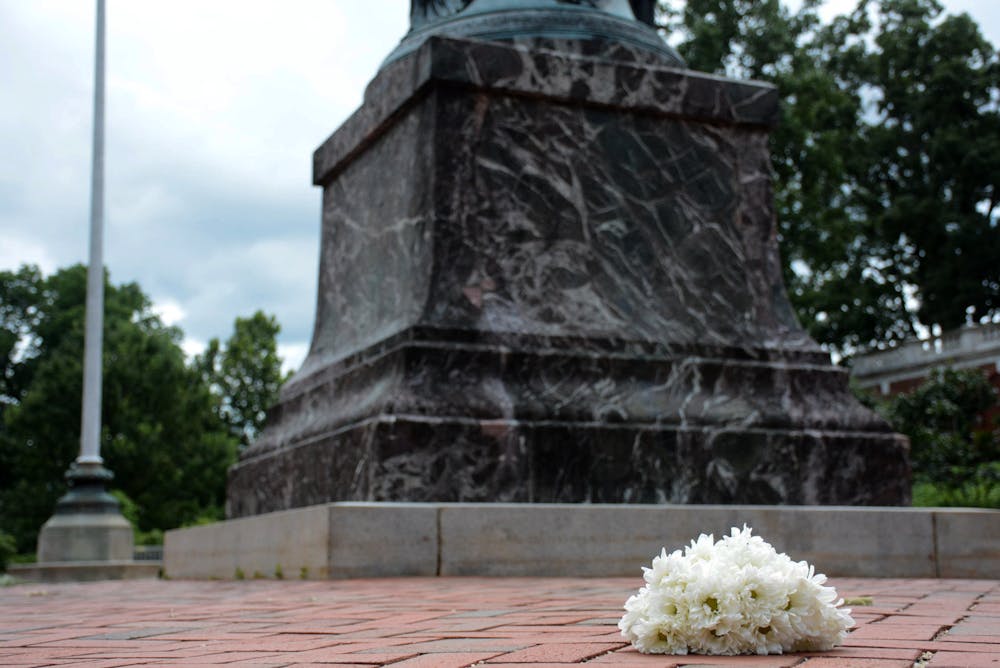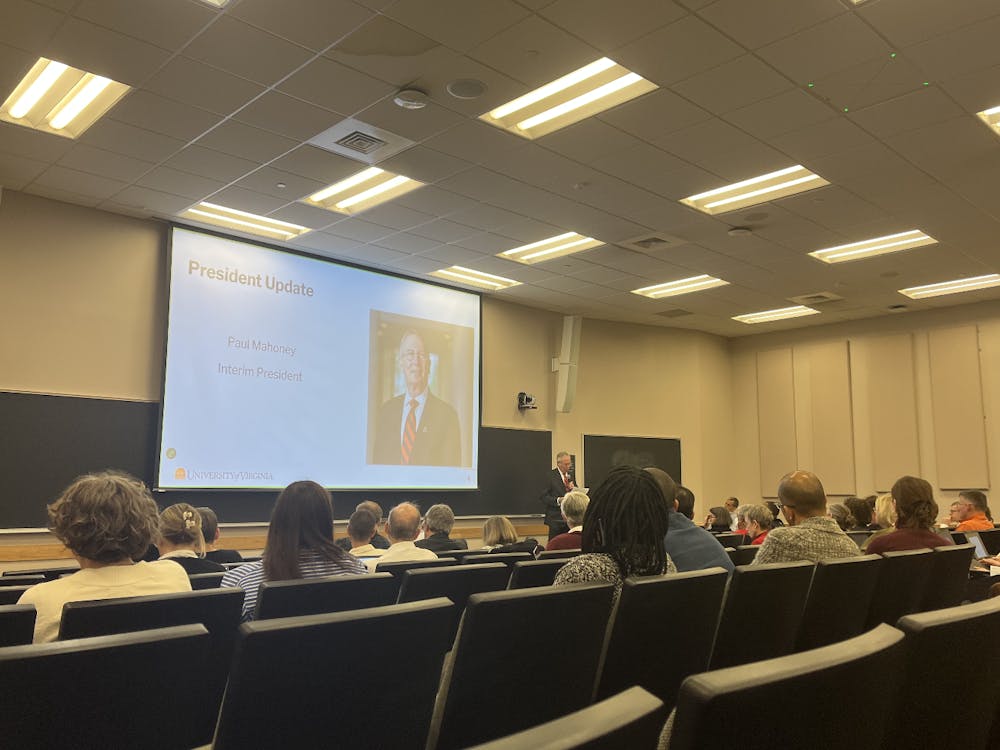Even five years later, most Charlottesville residents remember where they were on August 11 and 12, 2017, when white supremacists marched into their home wielding torches. University students who were on Grounds remember, too.
Benjamin Doherty, head of library instruction and a research librarian at the School of Law, was at a church across from the University at a prayer service Aug. 11, and watched as the white supremacists surrounded students at the Jefferson statue. The next day, Doherty would join thousands of counter-protestors at the Downtown Mall as the “Unite the Right'' rally commenced. They were there when James Fields drove his car into this group of protestors, killing Charlottesville resident Heather Heyer and injuring 19 others.
Kellen Squire, an emergency department nurse, was in the ER at Martha Jefferson Hospital, triaging injured patients. His wife worked beside him as the charge nurse in the department.
Christina Rivera, a Unitarian Universalist minister, witnessed the same “river of hate” that Doherty did as she stood with a group of clergy at church on August 11, and later would join them downtown the next day.
Dr. Kathryn Laughon, an associate professor in the School of Nursing, was at church both days, too, though she is not a churchgoer. She followed a group downtown as they confronted and disrupted the white supremacists.
Sarandon Elliott, a Class of 2022 alumna, was 70 miles away, just starting at community college.
In different places, with different communities, each felt the ripples from that day in a different way.
“This really was a reckoning,” Doherty said.
For many Charlottesville residents — especially those involved with organizing efforts or activism — the events of August 11 and 12 were not a surprise.
Doherty has lived in Charlottesville for 22 years, and worked at the Law Library for 18. Their wife is a professor in the English department, and the two are deeply involved in anti-racist efforts in Charlottesville — Doherty is an organizer with Showing Up for Racial Justice and was working with them in 2017.
“People have called it the ‘summer of hate’ because it really wasn't just August 11 and 12,” Doherty said. “We knew about [the ‘Unite the Right’ rally] months and months ahead of time, and started organizing months and months ahead of time.”
It was clear something was [brewing] as early as February, when City Council’s decision to remove the Robert E. Lee statue drew opposition and lawsuits. It was clear in May, when a group of protestors gathered in Market Street Park with torches to protest the decision, a demonstration the community compared to a Ku Klux Klan rally.
When members of the KKK held a rally in Court Square Park July 8, organizers and activists like Doherty and Laughon were not surprised — it was clear to them, too, that this was only the beginning.
Laughon, who has been teaching in Charlottesville since 2004, remembers the chaos of that day, the surrealness and disorder as an estimated 1,000 counter-protestors met 50 KKK members in the park. It was “total insanity.”
“I came home and I said ‘okay, we are past free speech,” Laughon said. “It is clear to me that, one, this is a danger. It is a danger to everyone. This is particularly a danger to the Black community in Charlottesville, to the Jewish community in Charlottesville.”
As news of the Aug. 12 rally began to circulate, Charlottesville residents voiced concerns about the way the city had handled the July 8 rally, and demanded that the city revoke the permit for the August rally. When it became clear that the rally would proceed, organizers prepared and discussed how they would face the white supremacists as the city planned to increase police presence and close roads in anticipation of the rally.
“We knew things were going to be bad,” Squire said. “I screamed, at everyone I could, just to be like, ‘this is going to be a much bigger deal. We need to pay attention.’”
Squire remembers a woman in the emergency room who was trying to get information about her family, throwing herself at him in “desperation.” Doherty remembers standing outside the church on August 11, serving as security for those inside and watching students surround the statue. He regrets not joining them himself. Laughon remembers being downtown at 5:30 in the morning on August 12, knowing the plan to confront the protestors was the right one, was the one that “took away their power.” Rivera remembers advice from her father, who told her never to turn her back on a person with a weapon — there was nowhere for her to turn on August 12, she said.
In the weeks following the rally, students and community members would criticize the way the city and University handled the rally — “all hands were, or should have been, on deck,” a leaked City Council memo read, detailing concerns about police inaction, insufficient security and failure by City communications to keep the public informed.
A report conducted by then-district attorney Tim Heaphy exposed failures by University law enforcement to handle the torchlit march August 11 — even though University officials knew about the march in advance, former University president Teresa Sullivan claimed in a video that “we didn’t know they were coming.”
“The University did nothing. The University simply let these white supremacists with their torches, walk right through campus and commit whatever violence they wanted to commit,” Doherty said. “But those students did not put up with that.”
That sentiment — that it came down to the students, to the organizers and activists, to resist the white supremacists who marched into Charlottesville Aug. 11 and 12 — was shared by Rivera and Laughon, too.
“I can’t watch those videos of August 11 — [the students] were just so f—ing brave,” Laughon said. “And then they were back out on August 12.”
Rivera said she realized after the rally that institutions like the University and police department did “not have any kind of a priority” in her safety — instead, she prioritized working with the “very strong core” of activists and organizers who “understood what it takes to get liberation.”
As Charlottesville and the University grappled with the traumatic effects of that summer, organizers and students continued that work. Students assembled to demand that the University take responsibility for its failures. A year after the rally, anti-racists held a series of demonstrations in solidarity with the community, and community members continued to hold the City accountable for its actions. On Grounds, students questioned the presence of Confederate monuments. In 2021, four years later, the community watched as Robert E. Lee and Thonas “Stonewall” Jackson were finally removed from their pedestals.
It’s the legacy of this activism that rings true for students and graduates like Elliott. She said it wasn’t until she was on Grounds that she understood how much the history of the University would affect her day-to-day life — and how she was able to take that history and learn from it.
Elliott was involved with the Black Student Alliance, chaired the Young Democratic Socialists of America at U.Va — and its national coordinating committee — and directed U.Va. Mutual Aid, a student-run collective that provides no-strings-attached grants to students in times of crisis.
“What happened that weekend, and especially seeing how, again, the University is complicit in so much harm… that's why I wanted to do the work that I did at the University,” Elliott said. “It was very important to me to build power, especially for the Black working class at U.Va.”
It is hard but important to maintain that institutional knowledge as student activists and organizers turn over every four years, Elliott said. But it is “100% students’ responsibility” to analyze the University, to hold the institution accountable and “turn [knowledge] into power.”
Rivera, too, encourages students “to not create a fictionalized version of the offense,” and to critically examine the narratives the University offers.
Those narratives include the way the University interacts with the Charlottesville community, Squire said, and encourages students to be “a part of making things better.”
“We can’t forget U.Va.’s role in this,” Laughon said. “We have, as a University community, a particular duty to recognize our complicity in that event, but also just in white supremacy and the continued need to confront that.”
Laughon, who is also the director of the PhD program at the School of Nursing, said she takes an hour at the start of each orientation with new students to discuss anti-racism in the classroom.
Outside of the classroom and away from Grounds, activists agree there is still far more work to be done to uproot the hate that embedded itself in Charlottesville’s history in 2017.
“We need to stay focused on pulling up those roots of white supremacy,” Doherty said.
Affordable housing, for example, is an issue the community has been focused on in the wake of the attacks as low-income citizens are pushed out of their neighborhoods. Low-income and non-white neighborhoods also struggle with access to healthy foods, a problem Charlottesville citizens in the Food Justice Network are trying to address. Rivera and Doherty both mentioned efforts to divert police resources back to the community, which have been ongoing for years.
Disrupting and facing white supremacy head-on, made a difference in August 2017, Doherty said — and it will continue to make a difference as Charlottesville citizens fight for a more equitable city.
“There is a terrible, horrible, racist legacy of evil, but it's also that legacy of courage,” Laughon said.
Congregate Charlottesville, a local, faith-based grassroots organization, is raising money for community members with ongoing needs arising from Aug. 11 and 12. You can donate to the fund here.







